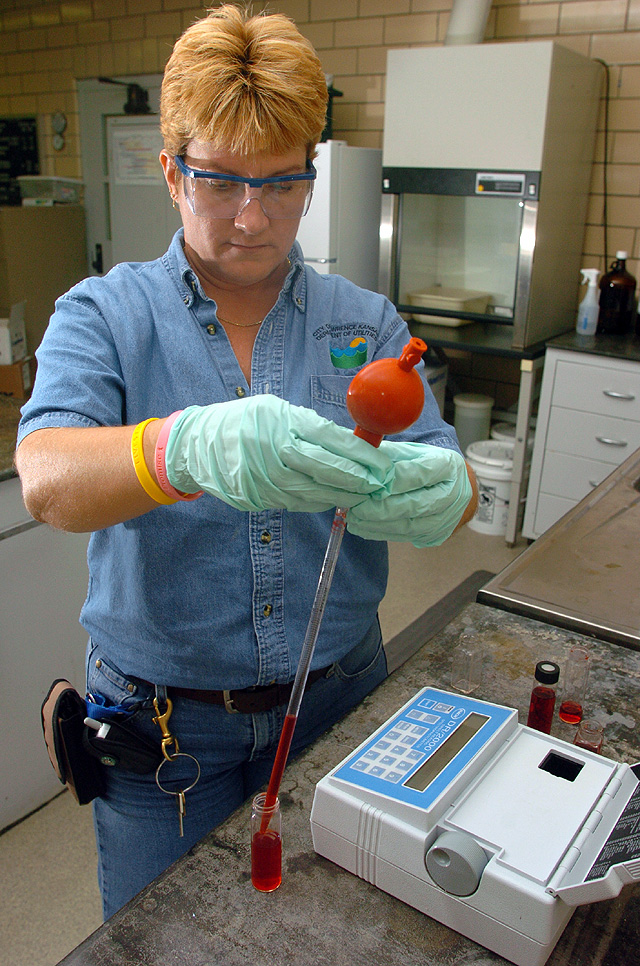Fluoride opponents’ argument gains teeth
Albert Burgstahler is convinced Lawrence residents have been forced to swallow a giant government mistake for more than 50 years.
“Anybody who drinks more than two or three quarts of water per day may be subject to problems,” said Burgstahler, a professor emeritus of chemistry at Kansas University.
That’s because Lawrence’s water, like that drunk by about 170 million people across the country, is treated with fluoride in an effort to improve dental health. But Burgstahler said he is convinced the additive is more a detriment than a benefit to well being.
It is an argument that a host of groups – many times branded as conspiracy theorists – have been making for decades. But recently, fluoridation opponents have gained new traction in their efforts to halt the water treatment.
A controversial study at Harvard has suggested a link between fluoride and a rare form of bone cancer. Several labor unions within the Environmental Protection Agency have now said they think fluoridation should be stopped until further studies can be done.
Closer to home, a debate raged in Hutchinson for much of last year before voters in November rejected a proposal that would have added fluoride to the city’s water supply.
An ‘albatross‘
Sixty years ago, Grand Rapids, Mich., became the first city in the country to fluoridate its water. Lawrence followed suit in 1953.

Donna Tucker, a city water treatment plant operater, tests some water to measure the amount of fluoride in Lawrence’s water supply. The city attempts to keep fluoride around 1 part per million, within the recommended guidelines of 0.7 to 1.2 ppm.
But Burgstahler – editor of the scientific journal “Fluoride” and a founding member of the anti-fluoridation Fluoride Action Network – said the past 60 years largely have been a farce.
He said there are studies suggesting fluoride doesn’t do much to prevent tooth decay. And studies that suggest a benefit don’t adequately consider other factors that would account for improved dental health, such as better diets. And Burgstahler said there are major studies that raise questions about the safety of fluoride – including some that suggest links to increased cancer rates, thyroid problems and skin conditions.
What’s worse, Burgstahler said, is that many of the government’s top public health agencies know about the concerns but are afraid to act.
“We got into this fluoridation with too much enthusiasm by public health officials in the 1950s,” Burgstahler said. “They basically have an albatross around their necks. They can’t admit they were wrong because it will cause a great deal of embarrassment and probably some lawsuits.”
‘Simply groundless’
To the dental community, Burgstahler’s theories sound as silly as an all-sugar diet.
“‘Simply groundless’ is the phrase that comes to mind,” said Greg Hill, assistant executive director of the Kansas Dental Assn., when asked about anti-fluoridation arguments. “You have to look at the people who do support fluoridation. These are the most well-respected health organizations in the country. If there was an inkling of doubt that this was safe, we wouldn’t be doing it.”

Among the strong supporters of fluoridation are the American Dental Assn. and the Centers for Disease Control and Prevention, which has proclaimed fluoridation one of the top 10 public health achievements of the 20th Century.
But controversy surrounding a federally-funded Harvard study has produced new fuel for the anti-flouridation movement.
Federal investigators and Harvard University officials announced last month they were investigating whether a Harvard professor concealed research suggesting a link between fluoridated water and bone cancer in young boys.
Chester Douglass, a professor in the Harvard School of Dental Medicine, told federal officials who funded a $1.3 million study that he knew of no significant link between fluoridated water and osteosarcoma, a rare and particularly fatal form of bone cancer.
But it later was learned that Douglass supervised research for a 2001 doctoral thesis that concluded boys exposed to fluoridated water at a young age were more likely to get the cancer. The doctoral thesis generally is considered to be the most rigorous study to link fluoride to the cancer, though there have been at least two other studies suggesting a link as well.
The study has generated significant coverage in the Washington Post and other media outlets, in part, because Douglass also serves as editor in chief for the industry-funded Colgate Oral Care Report. The connection has created questions about whether Douglass tried to bury the study’s findings to protect the fluoride industry.
Following the Harvard controversy, representatives from 11 of the EPA’s labor unions asked EPA administrators to create a new policy that would prohibit fluoridated drinking water.
EPA administrators have not done that, but they have commissioned a study by the National Academy of Sciences to examine safe levels of fluoridation. That report is expected next year.
A matter of trust
Fluoridation opponents say the recent questions surrounding the practice should raise red flags for the public. Fluoridation supporters disagree. Hill said it should not be alarming that the EPA has ordered a study because it routinely re-evaluates standards for a variety of chemicals.
As for the Harvard study, Hill said the dental community would be interested in the findings of the research. But he said one study was unlikely to present compelling evidence of a link between cancer and fluoride because numerous other studies have found no such link.
Other scientific groups also are not rushing to judgment. The National Cancer Institute still stresses on its Web site that “many studies” have found no link between fluoride and cancer rates.
Hill said members of the public should focus on the numerous studies that have found fluoride to reduce tooth decay by 15 to 40 percent, or research that suggests every $1 spent in fluoridation reduces dental costs by $38.
But fluoride opponents often see something else – a conspiracy – said Kim Moore, president of the Hutchinson-based United Methodist Health Ministry Fund, which offers financial assistance for communities interested in fluoridation.
“Very frequently we’re talking about people who don’t like having government tell us what to do,” Moore said of fluoridation opponents.
A government conspiracy theory is at the heart of one of the more popular books read by fluoride opponents.
“The Fluoride Deception” by Christopher Bryson alleges that water fluoridation in the 1940s was closely linked to the Manhattan Project and the making of the atomic bomb. Specifically, the book alleges that military and industry leaders were worried about lawsuits alleging that fluoride used in making the atom bomb was harmful to workers’ health. Introducing fluoride as a way to protect the dental health of children and others was an attempt to “launder” fluoride’s public image.
Moore said he was weary of the conspiracy arguments and believed that the majority of the public also was unconvinced that prominent public health organizations would lie to them.
“Did the CDC tell us the truth about the transmission of AIDS?” Moore asked. “Did the surgeon general tell us the truth about tobacco and cancer? They did. And they did so when there was a lot of pressure to not tell us. But they told the truth. They have a lot of credibility with me.”
Relying on experts
But Moore found out the hard way that not everyone in his hometown of Hutchinson is a fluoride believer. His organization offered a grant upward of $200,000 to fund fluoridation start-up efforts in Hutchinson.
City leaders accepted, but within a month a citizen’s group gathered 1,500 signatures to force the issue to a public vote. In November, residents – 52 percent to 48 percent – voted to nix plans to add fluoride to the water.
“People say the government wouldn’t lie to us,” said Wayne Logbeck, a Hutchinson resident who led the opposition group. “Excuse me. I was in the military. Half the time they were lying to us.”
Logbeck said he believes he is suffering health problems due to his fluoride exposure in the military and the amount of fluoride that occurs naturally in Hutchinson’s water supply.
“My heart has been calcified,” Logbeck said. “It looks like I have been pumping cement through my heart for 30 years.”
Logbeck said his doctors have not determined fluoride is the cause of his heart problems, but he strongly suspects it is the culprit based on information he’s read.
Health problems also prompted Burgstahler’s interest in fluoride research. He suffered an unexplained drop in thyroid activity, leading to sore joints and other metabolism-related problems. Those problems disappeared about three months after he began drinking distilled water, he said.
Hill, at the Kansas Dental Assn., said self-diagnosed fluoride ailments were common among fluoride opponents, but should be taken with a “grain of salt.”
At Lawrence’s two water treatment plants – which also provide treated water to Baldwin and Rural Water Districts Nos. 1, 2, 4, 5 and 6 – city officials aren’t looking to dive into the fluoride debate.
Chris Stewart, assistant director of utilities for water, said he mainly is concerned about keeping fluoride levels in the range found acceptable by a variety of fluoride experts. Generally, that is 0.7 to 1.2 parts per million. Stewart said Lawrence strives for its fluoride levels to be at about 1 part per million.
Stewart said his office does read the articles about the fluoride debate, but he said city officials don’t get caught up in them. Instead, he said the city relies on organizations such as the EPA and the Kansas Department of Health and Environment to post guidelines on what is acceptable.
“We rely upon the health agencies, and so far we have not seen anything to indicate that they’re changing their practices or are concerned,” Stewart said.


